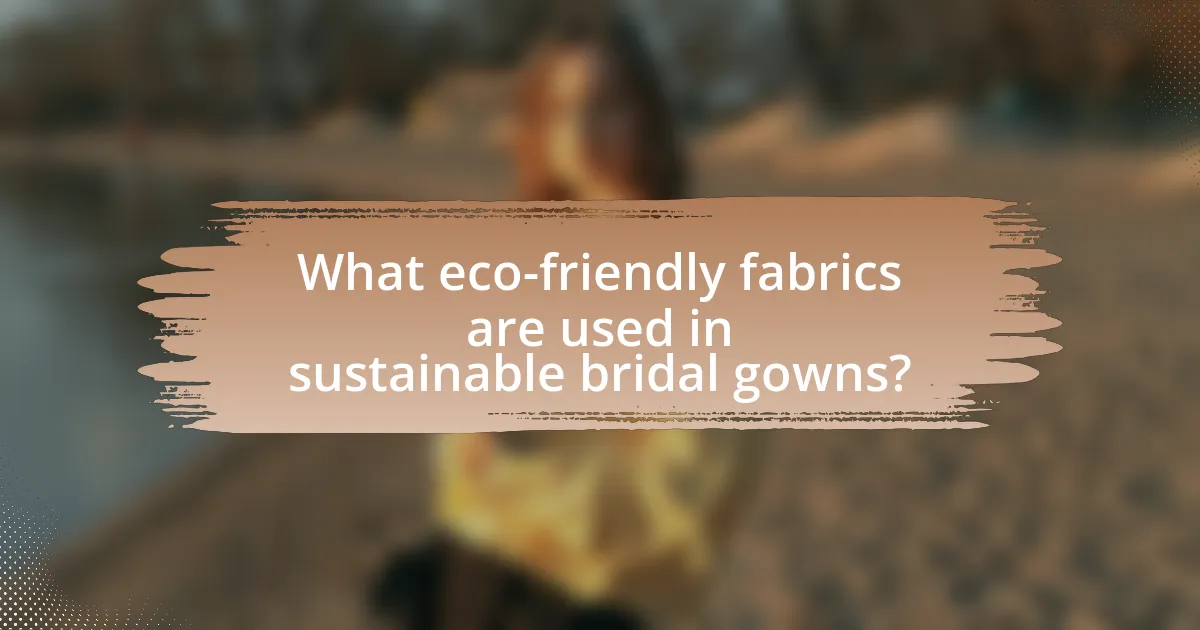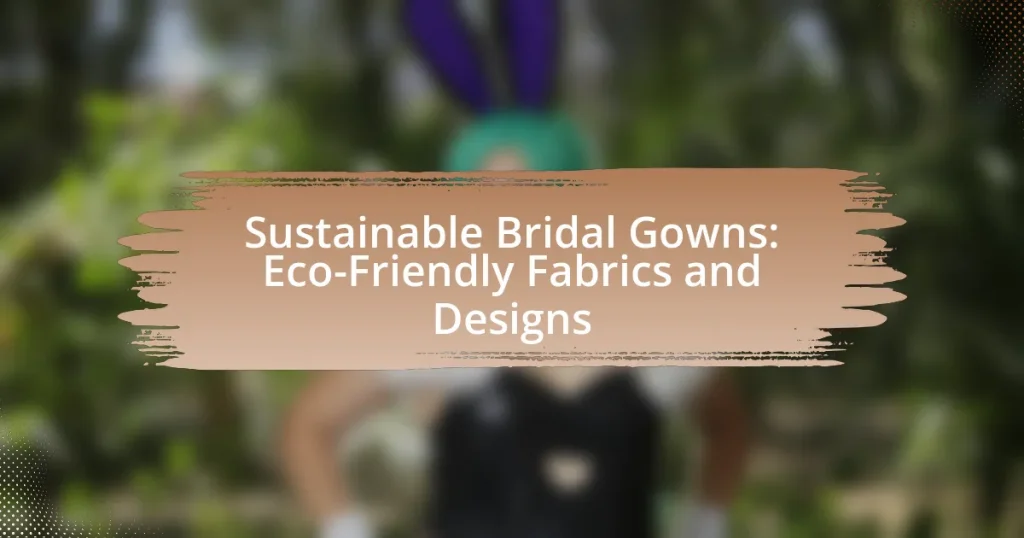Sustainable bridal gowns are wedding dresses crafted from eco-friendly materials and produced through environmentally conscious practices. These gowns typically utilize organic fabrics such as cotton, hemp, and recycled materials, significantly reducing the environmental impact associated with traditional gown production. The article explores the differences between sustainable and conventional gowns, the benefits of using eco-friendly fabrics, and the importance of ethical labor practices. It also highlights how consumer demand influences sustainable practices in the bridal industry and provides practical tips for brides to make informed choices when selecting their gowns.

What are Sustainable Bridal Gowns?
Sustainable bridal gowns are wedding dresses made from eco-friendly materials and designed with environmentally conscious practices. These gowns often utilize organic fabrics, such as organic cotton, hemp, or recycled materials, which reduce the environmental impact associated with traditional textile production. Additionally, sustainable bridal gowns may be produced by brands that prioritize ethical labor practices and minimize waste through techniques like made-to-order production or upcycling. This approach not only supports environmental sustainability but also promotes social responsibility within the fashion industry.
How do sustainable bridal gowns differ from traditional gowns?
Sustainable bridal gowns differ from traditional gowns primarily in their materials and production processes. Sustainable gowns are made from eco-friendly fabrics such as organic cotton, hemp, or recycled materials, which reduce environmental impact, while traditional gowns often utilize synthetic fabrics like polyester that contribute to pollution. Additionally, sustainable bridal gowns are produced using ethical labor practices and often involve local artisans, whereas traditional gowns may be mass-produced in factories with less regard for labor conditions. This commitment to sustainability is supported by the growing demand for environmentally responsible fashion, as evidenced by a 2021 report from McKinsey & Company indicating that 67% of consumers consider sustainability when making a purchase.
What materials are commonly used in sustainable bridal gowns?
Sustainable bridal gowns commonly utilize materials such as organic cotton, hemp, linen, Tencel, and recycled polyester. Organic cotton is grown without harmful pesticides, making it a safer choice for the environment. Hemp is a highly sustainable fiber that requires minimal water and no pesticides. Linen, derived from the flax plant, is biodegradable and uses fewer resources in its production. Tencel, made from sustainably sourced wood pulp, is known for its low environmental impact and biodegradability. Recycled polyester, produced from post-consumer plastic bottles, helps reduce waste and the need for virgin materials. These materials collectively contribute to the eco-friendliness of bridal gowns, aligning with sustainable fashion principles.
How does the production process of sustainable gowns impact the environment?
The production process of sustainable gowns positively impacts the environment by reducing waste and utilizing eco-friendly materials. Sustainable gowns are often made from organic fabrics, such as organic cotton or Tencel, which require fewer pesticides and water compared to conventional materials. Additionally, the production methods prioritize ethical labor practices and minimize carbon emissions through local sourcing and reduced transportation distances. According to a study by the Ellen MacArthur Foundation, transitioning to sustainable fashion can significantly lower the industry’s environmental footprint, highlighting the importance of sustainable practices in gown production.
Why is sustainability important in the bridal industry?
Sustainability is important in the bridal industry because it addresses environmental concerns associated with traditional wedding practices and materials. The bridal industry is known for its significant waste generation, with an estimated 300,000 wedding dresses discarded each year in the United States alone. By adopting sustainable practices, such as using eco-friendly fabrics and promoting ethical production methods, the industry can reduce its carbon footprint and minimize resource depletion. Furthermore, sustainable bridal options often emphasize quality over quantity, encouraging consumers to invest in timeless pieces that can be reused or repurposed, thereby fostering a more circular economy.
What are the environmental impacts of conventional bridal gown production?
Conventional bridal gown production has significant environmental impacts, primarily due to the use of non-biodegradable materials, high water consumption, and chemical pollution. The production of synthetic fabrics like polyester, commonly used in bridal gowns, contributes to plastic pollution, as these materials do not decompose and can persist in the environment for hundreds of years. Additionally, the textile industry is responsible for approximately 20% of global wastewater, with bridal gown manufacturing often involving extensive water usage for dyeing and finishing processes. Furthermore, the use of harmful chemicals in fabric treatments can lead to soil and water contamination, adversely affecting local ecosystems and communities.
How does consumer demand influence sustainable practices in bridal fashion?
Consumer demand significantly influences sustainable practices in bridal fashion by driving designers and brands to adopt eco-friendly materials and ethical production methods. As consumers increasingly prioritize sustainability, bridal fashion retailers respond by sourcing organic fabrics, utilizing recycled materials, and implementing transparent supply chains. For instance, a 2021 survey by the Ethical Fashion Forum found that 70% of brides expressed a preference for sustainable options, prompting many designers to create collections that align with these values. This shift not only meets consumer expectations but also fosters a competitive market where sustainability becomes a key differentiator.

What eco-friendly fabrics are used in sustainable bridal gowns?
Eco-friendly fabrics used in sustainable bridal gowns include organic cotton, hemp, linen, Tencel, and recycled polyester. Organic cotton is grown without harmful pesticides, making it a safer choice for the environment. Hemp is a highly sustainable crop that requires minimal water and no chemicals. Linen, made from flax, is biodegradable and has a low environmental impact. Tencel, produced from sustainably sourced wood pulp, is known for its softness and biodegradability. Recycled polyester, made from post-consumer plastic bottles, reduces waste and conserves resources. These fabrics collectively contribute to the sustainability of bridal fashion by minimizing environmental harm and promoting eco-conscious practices.
What are the benefits of using organic cotton in bridal gowns?
The benefits of using organic cotton in bridal gowns include environmental sustainability, reduced chemical exposure, and enhanced comfort. Organic cotton is grown without synthetic pesticides and fertilizers, which minimizes soil and water pollution, contributing to a healthier ecosystem. Additionally, organic cotton is softer and more breathable than conventional cotton, providing greater comfort for the wearer. Studies indicate that organic farming practices can reduce water usage by up to 90% compared to conventional methods, further supporting its eco-friendly credentials.
How does organic cotton compare to conventional cotton?
Organic cotton is produced without synthetic pesticides and fertilizers, making it more environmentally friendly compared to conventional cotton, which often relies on these chemicals. The cultivation of organic cotton promotes biodiversity and soil health, as it uses crop rotation and natural pest control methods. According to the Organic Trade Association, organic cotton farming uses 71% less water than conventional methods, highlighting its sustainability benefits. Additionally, organic cotton is often grown under stricter regulations, ensuring better labor practices and reduced exposure to harmful chemicals for farmers.
What certifications should consumers look for in organic cotton fabrics?
Consumers should look for certifications such as Global Organic Textile Standard (GOTS) and OEKO-TEX Standard 100 when selecting organic cotton fabrics. GOTS ensures that the cotton is grown organically and processed in an environmentally and socially responsible manner, while OEKO-TEX Standard 100 certifies that the fabric is free from harmful substances. These certifications provide assurance of the fabric’s organic integrity and safety for consumers, aligning with sustainable practices in the textile industry.
What role do recycled materials play in sustainable bridal gowns?
Recycled materials are essential in sustainable bridal gowns as they significantly reduce environmental impact by minimizing waste and resource consumption. By utilizing fabrics made from post-consumer waste, such as recycled polyester from plastic bottles, designers can create gowns that maintain quality while promoting circular fashion. For instance, the use of recycled materials can lower carbon emissions by up to 75% compared to traditional fabric production methods. This approach not only conserves natural resources but also supports the growing demand for eco-conscious fashion, making recycled materials a pivotal component in the development of sustainable bridal wear.
How are recycled fabrics sourced and processed for bridal wear?
Recycled fabrics for bridal wear are sourced primarily from post-consumer textile waste, such as discarded garments and fabric scraps. These materials are collected through recycling programs and initiatives aimed at reducing textile waste. The processing involves several steps: first, the collected textiles are sorted by type and color, then they are shredded and cleaned to remove contaminants. After cleaning, the fibers are either spun into new yarns or directly used in their shredded form to create new fabric. This method not only conserves resources but also significantly reduces the environmental impact associated with traditional fabric production, as it requires less water and energy. According to the Ellen MacArthur Foundation, recycling textiles can reduce greenhouse gas emissions by up to 80% compared to producing new fibers.
What are the advantages of using recycled polyester in bridal gowns?
Recycled polyester offers several advantages in bridal gowns, primarily its environmental benefits and durability. Utilizing recycled polyester reduces reliance on virgin petroleum-based materials, thereby lowering carbon emissions and energy consumption associated with production. According to the Textile Exchange, using recycled polyester can save up to 75% of the energy required to produce new polyester. Additionally, recycled polyester is often more resistant to wrinkles and shrinking, enhancing the longevity and wearability of bridal gowns. This fabric also supports the circular economy by diverting plastic waste from landfills, contributing to a more sustainable fashion industry.

What design elements contribute to the sustainability of bridal gowns?
Design elements that contribute to the sustainability of bridal gowns include the use of eco-friendly fabrics, minimalistic designs, and versatile styles. Eco-friendly fabrics, such as organic cotton, hemp, and Tencel, reduce environmental impact by utilizing sustainable farming practices and biodegradable materials. Minimalistic designs often require less fabric and fewer resources, promoting a lower carbon footprint. Versatile styles, which can be worn for multiple occasions, encourage longevity and reduce the need for multiple purchases. These elements collectively enhance the sustainability of bridal gowns by prioritizing environmental responsibility and resource efficiency.
How can minimalist designs enhance sustainability in bridal fashion?
Minimalist designs enhance sustainability in bridal fashion by reducing material waste and promoting timeless styles. These designs typically use fewer fabrics and embellishments, which decreases the overall environmental impact associated with production. For instance, a study by the Ellen MacArthur Foundation highlights that the fashion industry generates 92 million tons of waste annually, much of which can be mitigated through simpler, more efficient design approaches. Additionally, minimalist bridal gowns often prioritize quality over quantity, encouraging consumers to invest in pieces that can be worn multiple times or passed down, further extending the lifecycle of the garment.
What are the key features of minimalist bridal gown designs?
Minimalist bridal gown designs are characterized by simplicity, clean lines, and a focus on essential elements without excessive embellishments. These gowns often utilize high-quality fabrics such as silk, cotton, or linen, emphasizing natural materials that align with sustainable practices. The silhouettes are typically streamlined, featuring A-line or sheath shapes that enhance the bride’s natural form. Additionally, minimalist designs often incorporate subtle details like delicate seams or understated necklines, which contribute to an elegant yet unpretentious aesthetic. This approach not only reflects a modern sensibility but also supports eco-friendly fashion by prioritizing timelessness over trends, reducing waste in the bridal industry.
How does a minimalist approach reduce waste in gown production?
A minimalist approach reduces waste in gown production by emphasizing simplicity in design and materials, which leads to fewer resources being used. This approach often involves creating gowns with fewer embellishments and using only essential fabrics, thereby minimizing excess material and reducing the likelihood of leftover scraps. For instance, brands that adopt minimalist designs can achieve a reduction in fabric waste by up to 30%, as reported in studies on sustainable fashion practices. Additionally, streamlined production processes associated with minimalist designs can lead to lower energy consumption and reduced emissions, further contributing to waste reduction in the overall gown production lifecycle.
What are the benefits of custom-made sustainable bridal gowns?
Custom-made sustainable bridal gowns offer several benefits, including personalized fit, eco-friendly materials, and ethical production practices. These gowns are tailored to the bride’s specific measurements, ensuring comfort and style that off-the-rack options may not provide. Additionally, sustainable bridal gowns often utilize organic or recycled fabrics, reducing environmental impact compared to conventional materials. Ethical production practices, such as fair labor conditions and reduced waste, further enhance the appeal of these gowns, aligning with the values of environmentally conscious consumers. According to a report by the Ellen MacArthur Foundation, the fashion industry is responsible for 10% of global carbon emissions, highlighting the importance of sustainable choices in reducing this footprint.
How does customization reduce the environmental impact of bridal wear?
Customization reduces the environmental impact of bridal wear by allowing for the use of materials and designs that are specifically tailored to the bride’s preferences, minimizing waste. When bridal wear is customized, it often involves creating garments that fit the individual perfectly, which reduces the need for alterations and the associated fabric waste. Additionally, customization can prioritize the use of sustainable fabrics, such as organic cotton or recycled materials, which have a lower environmental footprint compared to conventional fabrics. According to a study by the Ellen MacArthur Foundation, the fashion industry contributes to 92 million tons of waste annually, highlighting the importance of reducing waste through tailored solutions. By focusing on individual needs and sustainable practices, customization effectively lowers the overall environmental impact of bridal wear.
What should brides consider when opting for a custom gown?
Brides should consider the environmental impact of materials and production methods when opting for a custom gown. Sustainable fabrics, such as organic cotton, hemp, and recycled materials, reduce ecological footprints and promote ethical fashion practices. Additionally, brides should evaluate the craftsmanship and sourcing of their gown, as local production can minimize carbon emissions associated with transportation. Research indicates that the fashion industry contributes significantly to pollution, with sustainable practices offering a viable alternative for eco-conscious consumers. By prioritizing these factors, brides can make informed choices that align with their values and contribute to a more sustainable future in bridal fashion.
How can brides make informed choices about sustainable bridal gowns?
Brides can make informed choices about sustainable bridal gowns by researching the materials, production processes, and certifications associated with the gowns. Understanding eco-friendly fabrics such as organic cotton, Tencel, and recycled polyester is crucial, as these materials have a lower environmental impact compared to conventional fabrics. Additionally, brides should seek out designers who prioritize ethical labor practices and transparency in their supply chains. Certifications like Global Organic Textile Standard (GOTS) or OEKO-TEX can also guide brides in identifying truly sustainable options. By evaluating these factors, brides can select gowns that align with their values and contribute to a more sustainable fashion industry.
What questions should brides ask designers about sustainability practices?
Brides should ask designers about their sustainability practices by inquiring whether they use eco-friendly materials and ethical production methods. Specifically, brides can ask if the fabrics are sourced from sustainable suppliers, if the production process minimizes waste, and if the labor practices adhere to fair trade standards. Additionally, brides should inquire about the designer’s commitment to reducing their carbon footprint and whether they offer options for upcycling or recycling the gown after the wedding. These questions are crucial as they help ensure that the bridal gown aligns with the bride’s values regarding environmental responsibility and ethical consumption.
How can brides assess the sustainability of a bridal gown before purchase?
Brides can assess the sustainability of a bridal gown before purchase by examining the materials used, the manufacturing processes, and the brand’s ethical practices. Specifically, they should look for gowns made from eco-friendly fabrics such as organic cotton, hemp, or recycled materials, which have a lower environmental impact compared to conventional fabrics. Additionally, brides should inquire about the production methods, ensuring that the gown is made in facilities that prioritize fair labor practices and minimize waste. Brands that provide transparency regarding their supply chain and sustainability certifications, such as Global Organic Textile Standard (GOTS) or OEKO-TEX, further validate their commitment to sustainable practices. This approach allows brides to make informed choices that align with their values regarding environmental responsibility and ethical consumption.
What are some practical tips for choosing a sustainable bridal gown?
To choose a sustainable bridal gown, prioritize eco-friendly fabrics such as organic cotton, hemp, or Tencel, which have lower environmental impacts compared to conventional materials. Additionally, consider purchasing from designers who emphasize ethical production practices, ensuring fair labor conditions and minimal waste. Researching second-hand options or rental services can also significantly reduce the carbon footprint associated with new garment production. According to the Ellen MacArthur Foundation, the fashion industry contributes to 10% of global carbon emissions, highlighting the importance of sustainable choices in bridal wear.










